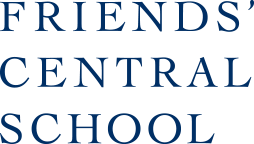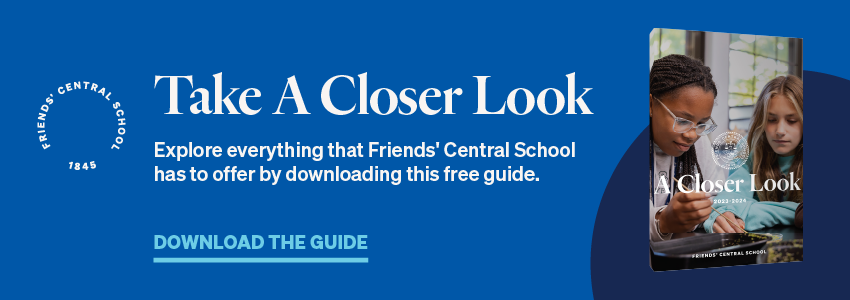
When you are looking for a private or independent school to enroll your child in, then you know there are a lot of factors to take into consideration before you make your final decision: What is the student-to-teacher ratio, what is the school’s educational philosophy, etc.
If you value a hands-on education for your child, and one that focuses on real-world applications, then there’s another question you should be asking the admissions team: Does the school have a Makerspace?
What is a Makerspace?
A makerspace is, essentially, a workshop where people can go to create things in a collaborative setting with other makers. Sometimes makerspaces are found as private businesses, where makers can pay a membership fee for access to the facility. But more and more often, they are being found in public areas like libraries and schools.
Free Downloadable Guide: Take a Closer Look at Friends' Central School
When a makerspace is found in a school, it is typically used to support the school’s Maker Education program, which focuses on interdisciplinary, hands-on problem solving.
What are the benefits of attending a school with a makerspace?
Many parents would put having a makerspace on their list of “nice-to-haves” for the schools that they are considering enrolling their child in. But the truth is, if you value a hands-on education that teaches your child the real-world applications of their lessons, whether or not a school has a makerspace should be a primary point of consideration.
Below are some of the most important reasons that parents should prioritize enrolling their child in a school with a makerspace.
1. Having a makerspace shows that the school prioritized maker and STEM education.
Though not every high-quality school will have a makerspace or maker lab, having one is a signal that the school prioritizes Maker- and STEM-based education. This is incredibly important, especially for today’s students. Maker Ed programs and STEM-based curriculum bring a slew of educational benefits, including:
- Reinforced lessons: Lessons from one class are reinforced in related classes, helping students retain their lessons and see the relationship between different pieces of knowledge.
- Real-world applications: The hands-on approach inherent in Maker Ed programs show students the real-world applications of their lessons, which helps them to understand why they learn the things that they learn.
- Job prep: STEM and Maker Ed tend to focus (at least to some extent) on new and emerging technologies and skills that are bound to influence the jobs that today’s students are likely to perform after graduation. The earlier children begin being exposed to these technologies and skills, the better.
- Increased creativity, curiosity, and critical thinking: A quality Maker Ed program will be designed in a way that prioritizes problem solving in a way that helps children build their critical thinking skills.
2. Makerspaces encourage collaboration.
Makerspaces, especially in a school setting, tend to be organized along an open floor plan. This means that individual students and groups of students are often working to solve different problems within an arm’s reach of each other.
The nature of how makerspaces are set up and organized makes them an ideal environment to encourage collaboration between students. It allows for an open flow of ideas, as students can watch and learn from their classmates as they each solve their own problems, which can lead to some truly innovative solutions.
Beyond this, the community-based nature of a makerspace helps to break down some of the barriers that may keep a student from seeking help when they are unsure of what to do next. Seeking help from others is an important skill for all children to learn, and makerspaces prove to be optimal environments to do just that.
3. Makerspaces give students access to technology that is hard to come by at home.
One of the major benefits of your child’s school having a makerspace is the fact that it means they have access to technology, tools, and educational resources that would likely be too expensive for you to own in the home. This involves high-tech gadgets like 3D printers, laser cutters, and computer programming kits to low-tech items like sewing machines, camera equipment, bandsaws, and more.
Access to these tools will give your child exposure to some emerging technologies that they are likely to need to leverage later in their education and careers. But more importantly, access to so many different tools will help your child to come up with creative, innovative solutions to the problems that they are tasked with solving.
4. Makerspaces can help make learning fun.
Students who have worked in a makerspace as a part of their education often describe them as “not feeling like school.”
There’s just something different about the hands-on environment found in a makerspace that makes them very different from a traditional classroom experience. This comes from the fact that the student isn’t just learning about something; they are learning by doing, which makes the lesson more engaging, more interesting, and more fun.
While not the primary focus of Maker Ed, it never hurts to make learning a fun experience for your child.
The Right Environment for Learning
What makes a makerspace so powerful is the fact that it is an environment specifically designed to encourage hands-on learning and problem solving, which are incredibly important in inspiring a love of learning in your child that will propel them throughout their life. Whether or not your child’s school has a makerspace is a quick way for you to understand whether or not the school shares the same educational priorities that you do, and for that reason, it should be on the list of qualities that you evaluate as you search for a school for your child.



